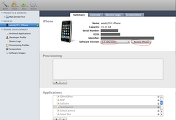최초 작성일 : 2010/04/17 04:21
@interface RootViewController : UITableViewController {
NSArray *regions;
}
//지역 객체를 담을 배열 선언
@property (nonatomic, retain) NSArray *regions;
@end
#import "RootViewController.h"
#import "SimpleSectionedTableViewAppDelegate.h"
#import "Region.h"
#import "TimeZoneWrapper.h"
//어떤 경우에 사용되는지 잘 모르겠음…???
NSString *localeNameForTimeZoneNameComponents(NSArray *nameComponents);
NSMutableDictionary *regionDictionaryWithNameInArray(NSString *name, NSArray *array);
@implementation RootViewController
@synthesize regions;
#pragma mark -
#pragma mark View lifecycle
- (void)viewDidLoad {
//Foundation Framework에 있는 함수로 NSBundle.h에 선언되어있음. Localizable.string에 있는 파일에서
//key가 "Time Zones"로 되어있는 값을 가져옴
self.title = NSLocalizedString(@"Time Zones", @"Time Zones title");
}
#pragma mark -
#pragma mark Table view data source methods
- (NSInteger)numberOfSectionsInTableView:(UITableView *)tableView {
// Number of sections is the number of regions.
//섹션의 수는 regions 배열의 크기를 돌려줌
return [regions count];
}
- (NSInteger)tableView:(UITableView *)tableView numberOfRowsInSection:(NSInteger)section {
// Number of rows is the number of time zones in the region for the specified section.
//각 섹션에 있는 행의 수는 regions 배열에 들어있는 각각의 region 인스턴스로부터
//TimeZoneWrapper 클래스의 배열인 timeZoneWrappers의 크기를 돌려줌
Region *region = [regions objectAtIndex:section];
return [region.timeZoneWrappers count];
}
- (NSString *)tableView:(UITableView *)tableView titleForHeaderInSection:(NSInteger)section {
// The header for the section is the region name -- get this from the region
//at the section index.
//각 섹션의 제목은 regions 배열의 section 위치에 있는 region 인스턴스로부터 name 속성을 사용함
Region *region = [regions objectAtIndex:section];
return [region name];
}
- (UITableViewCell *)tableView:(UITableView *)tableView cellForRowAtIndexPath:(NSIndexPath *)indexPath {
//cell의 재활용을 위해 아이디를 부여
static NSString *MyIdentifier = @"MyIdentifier";
//재활용할 cell이 없으면 새로 생성
UITableViewCell *cell = [tableView dequeueReusableCellWithIdentifier:MyIdentifier];
if (cell == nil) {
cell = [[[UITableViewCell alloc] initWithStyle:UITableViewCellStyleDefault
reuseIdentifier:MyIdentifier] autorelease];
}
// Get the section index, and so the region for that section.
//NSIndexPath는 일련의 배열들의 트리 구조를 표현 하는 것으로 부여되는 값들은
//각각 다음 단계 배열의 인덱스를 의미한다. 여기서는 index path가 section - row로 이어지면
//각각 지역 정보를 가지고 있는 regions 배열의 인덱스와 time zone의 정보를 가지고 있는
//timeZoneWrappers 배열의 인덱스를 의미한다.
//index path에서 regions의 인덱스를 가져와 해당 인덱스의 region 인스턴스를 가져온다.
Region *region = [regions objectAtIndex:indexPath.section];
//regions로부터 가져온 region 인스턴스의 timeZoneWrappers 배열에서 index path에
//있는 timeZoneWrappers의 인덱스를 가져와 해당 위치의 timeZoneWrapper 인스턴스를 가져온다.
TimeZoneWrapper *timeZoneWrapper = [region.timeZoneWrappers objectAtIndex:indexPath.row];
// Set the cell's text to the name of the time zone at the row
//가져온 timeZoneWrapper에 선언된 localeName 속성을 이 셀의 제목으로 설정한다.
cell.textLabel.text = timeZoneWrapper.localeName;
return cell;
}
#pragma mark -
#pragma mark Table view delegate method
/*
To conform to Human Interface Guildelines, since selecting a row would have no effect (such as navigation), make sure that rows cannot be selected.
*/
//특정 위치의 셀이 선택되었을 때 처리 내용이 들어갈 메서드
- (NSIndexPath *)tableView:(UITableView *)tableView willSelectRowAtIndexPath:(NSIndexPath *)indexPath {
return nil;
}
#pragma mark -
#pragma mark Memory management
//메모리 해제
- (void)dealloc {
[regions release];
[super dealloc];
}
@end
'Development > iPhone' 카테고리의 다른 글
| [옛 글] iPhone OS 4 간략 사용기 (변화된 점 위주로) (0) | 2013.07.16 |
|---|---|
| [옛 글] [APIs] NSIndexPath (0) | 2013.07.16 |
| [옛 글] SimpleSectionedTableView - SimpleSectionedTableViewAppDelegate (0) | 2013.07.15 |
| [옛 글] [Methods] SimpleSectionedTableView - 모델 클래스에 사용된 메서드 정리 (0) | 2013.07.12 |
| [옛 글] [APIs] NSSortDescriptor (0) | 2013.07.12 |

